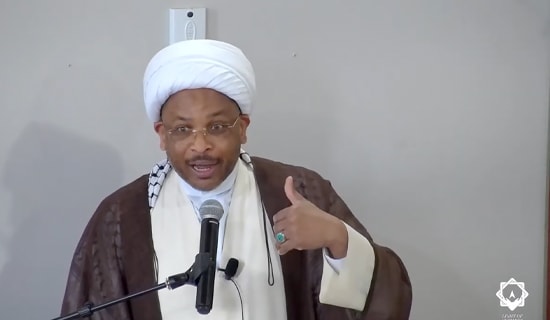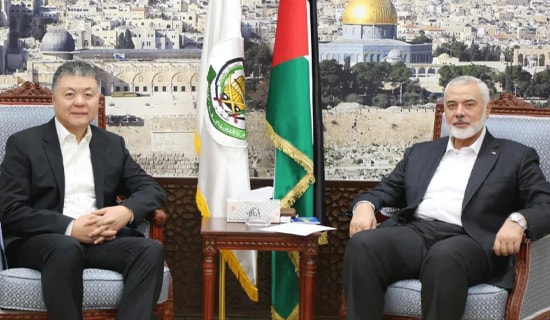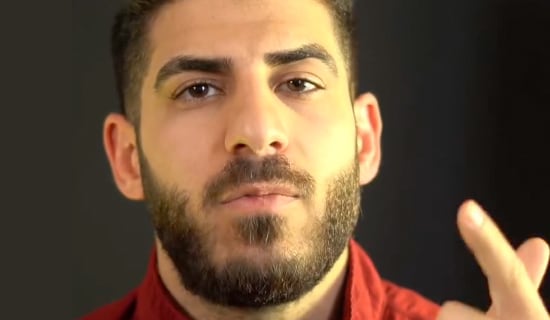Since Iran's Islamic Revolutionary Guards Corps (IRGC) conducted the Great Prophet 9 maneuvers on February 25-27, 2015, which culminated in a takeover and sinking of a model of an American Nimitz-class aircraft carrier,[1] the Iranian regime has escalated its naval threats against the U.S. These have included threats to take over and sink American aircraft carriers and other warships; to close the Strait of Hormuz and Bab El-Mandeb; to carry out large-scale missile attacks inside and outside the Persian Gulf; and to mine the Persian Gulf.
Tehran's recognition of its technological inferiority vis-à-vis the West has long since led it to adopt an asymmetric strategy,[2] including a naval aspect; this naval strategy relies, inter alia, on the use of suicide attacks and on Iran's missile capabilities.[3]
During the Great Prophet 9 maneuvers, IRGC deputy commander Hossein Salami said that according to Iran's strategic plan, Iran would attempt to take over aircraft carriers, and that if these attempts were met with resistance, but it would sink them if it encountered resistance. He noted that Iran would fire missile barrages, and that since it has accurately hit a vessel 60 meters long, it could easily target American aircraft carriers. IRGC naval commander Ali Fadavi said that vessels in the Persian Gulf, the Strait of Hormuz, the Gulf of Oman, and the northern Indian Ocean are all within range of Iran's missiles and under the threat of its warships.
In early March 2015, Hossein Dalirian, a journalist for the website Tasnim, which is close to the IRGC, tweeted images of an IRGC speedboat approaching American ships in the Persian Gulf and photographing them.
Recently, regime officials and mouthpieces have also renewed threats to close the Strait of Hormuz. Ali Fadavi threatened to close it in response to American interference, while the regime mouthpiece Kayhan called for its closure and stated that Iran needed to cause the West economic damage similar to the damage caused to Iran by the sanctions.
At the same time, Nasim Online, a website close to the IRGC, explained that Tehran's recent threats to close the Strait of Hormuz would be actualized only if Iran were to be attacked.[4]
Also, following the Houthi takeover of the regime in Sana'a, Yemen, there was a proliferation of statements on the Iranian presence in Bab El-Mandeb and on the rise of a decisive Iranian naval force in the Persian Gulf and on the Mediterranean coast.
This paper will review Iran's recent naval threats:
Threats To Use Suicide Speedboats Against U.S. Forces In The Gulf
On February 25, 2015, the website Tasnim, which is close to the IRGC, published a video showing "the moment of impact between an unmanned IRGC suicide boat and a model of the American aircraft carrier."
In a March 5, 2015 interview with Iranian TV, IRGC deputy commander Hossein Salami explained that Iran would rather take over than sink American aircraft carriers and warships, but that it would sink them if it encountered resistance: "Our goal is to disable the warships and take them over, not sink [them]. The reason is humanitarian, since these warships hold 6,000 crew. We will sink them only if there is resistance...
"Aircraft carriers are customarily an international symbol of the superpowers, especially of America. These warships are dispersed across the world, and the superpowers, especially America, gain a political boost from their intimidation factor. You would be hard pressed to find countries that believe they can overcome this asset. Iran is among the few countries that have overcome the image that the enemy wishes to create regarding its strength. These forces are supposedly large, but at the same time, they are vulnerable. If any nation decides to overcome a certain phenomenon, it will undoubtedly use all the necessary means to defeat that force..."
Referring to surface-to-sea missiles, Salami added: "These mobile missiles are launched while completely invisible and undetectable... One of our strategic goals is to reduce the deviation of these missiles, and today, thanks to the efforts of Iran's revolutionary youth, the surface-to-sea missiles have zero deviation, and when a missile is fired, it is aimed at the stern of the warship. We are able to launch hundreds of such missiles simultaneously...
"The Khalij-e Fars is a ballistic missile that is different from a cruise missile. It has extraordinary in-atmosphere velocity, and can hit a moving target hundreds of kilometers away with zero deviation... This missile was successfully launched during the recent maneuvers, and managed to strike a moving vessel 60 meters [long]. When a ballistic missile can deliver a pinpoint strike to a target several times smaller than an aircraft carrier, is it not the time to realize that the aircraft carrier story is over? ... In effect, we will not fire one or two missiles, but huge barrages..."[5]

Khalij-e Fars missile strikes aircraft carrier model during IRGC maneuvers (Source: Mashregh, Iran, February 25, 2015)
Threats To Close The Strait Of Hormuz And Bab El-Mandeb
IRGC Navy Commander: We Will Close The Strait Of Hormuz In Response To American Interference
In a March 2, 2015 interview on Al-'Alam TV, IRGC Navy Commander Ali Fadavi said: "The Americans' arrival in the area - despite their claim that this was meant to strengthen regional security and stability - has increased the dangers encountered by vessels in the Gulf. The Americans are not in a situation that allows them to threaten the security of the Persian Gulf.
"It is the Americans, more than us, who seek to avoid fighting, because the situation does not allow them to do so. The IRGC oversees the region day and night, and the distance between us and the Americans, when they wish to cross the Strait of Hormuz, is only a few hundred meters. Contacts between us and the Americans in the Strait of Hormuz take place as part of international law and regulations. We have enough strength to keep the Strait of Hormuz open for the use of all countries. American interference will lead to its closure. It is our religious duty [to ensure] that energy can pass through the Strait of Hormuz so that the world suffers no harm.
"In the recent maneuvers, we tested strategic weapons whose power and effectiveness the Americans cannot estimate, but also cannot ignore. The incorporation of these new weapons plays a critical role in increasing Iran's naval strength to deal with threats to the Islamic Revolution, and especially against the Great Satan - America."[6]
Kayhan: Why Shouldn't Iran Close The Strait Of Hormuz?
SUPPORT OUR WORK

On February 28, 2015, the regime mouthpiece Kayhan called for closing the Strait of Hormuz. An article titled "The Strait of Hormuz - A Tool For Sanctions Against Sanctions" stated that "some 68% of the world's oil and gas reserves pass through the Strait of Hormuz, and [therefore] the security of the Strait of Hormuz plays a key role in the world's uninterrupted supply of energy... Their closure would be a nightmare for America and the global economy. Aside from the deadly impact of shutting down the world's energy lifeline, the most important aspect is the impact of the challenge to American hegemony. It has indeed been challenged in several other arenas, but [closing the Strait of Hormuz] could make it the graveyard of the American superpower...
"Western countries, chiefly America, have turned Iran's civilian nuclear activity into a political matter, and are using this conflict to leverage sanctions to achieve their goals. Under these circumstances, and when the Islamic Republic has the capability, why shouldn't it close the Strait of Hormuz in response to Western sanctions? If Western countries disrupt oil sales and harm Iran's economy by using their leverage, why should Iran allow them easy access to energy? ...
"Why not use all our leverage against the enemy? The Great Prophet 9 maneuvers were a practical exercise in doing this, and the Americans, more than anyone else, internalized their clear message that the option of sanctions will not be without their price, and could involve specific conflicts [for the Americans]."[7]

February 26, 2015 front page of the daily Vatan-e-Emrooz: "The Hormuz Option"

February 28, 2015 front page of the daily Kayhan: "Message Of Great Prophet Maneuvers: The Strait Of Hormuz - A Tool For Sanctions Against Sanctions"
IRGC Navy Commander: Persian Gulf, Strait Of Hormuz, Gulf Of Oman All In Range Of Iranian Missiles
In a February 25, 2015 interview with Iranian TV, IRGC Navy Commander Ali Fadavi said: "Our enemy will never know the full extent of our capabilities - except on the battlefield, when it will be too late... The entire Persian Gulf, the Strait of Hormuz, and the entire Gulf of Oman to the northern Indian Ocean are within the range of our weapons and our ships, and are subject to the decision-making of our fighters. The Americans are aware of this at all times. Perhaps they know this even better than our own public. The Americans can sense these capabilities near them. You [i.e. Iranian TV] may have footage of the daily interaction between us and our enemies - the Americans and their allies - in the Persian Gulf.
"You can see there how every foreign ship that enters the region comes under close surveillance through the various intelligence means at our disposal. The Americans are incapable of doing anything undetected by the hawk-eyes of the fighters of Islam...
"They know better than ever before that they must not even think about initiating any confrontation against the Islamic Revolution. That's what deterrence is all about...
"I can say with confidence that today, America is the leading country in the world to take care not to accidentally fire a single bullet in the Persian Gulf. They know that they will be the biggest losers in the confrontation that will ensue from that shot. That is why they are careful... Nobody in America, no political or military official, even thinks with a single brain cell about war with the Islamic Revolution. The occasional statements by the U.S. president that all options are on the table have become a farce, a joke, even among the U.S. officials."
Iranian Officials: Iran Has A Presence In Bab El-Mandeb
In addition, in the wake of the recent Houthi takeover of Sana'a, Iranian officials announced an Iranian presence in Bab El-Mandeb. On March 9, 2015, Iranian Supreme National Security Council secretary Ali Shamkhani stated: "Iran has linked to Bab El-Mandeb and to the Mediterranean."[8] Iranian Army naval commander Habibollah Sayyari also noted: "There are nine important sea passages in the world, and Iran oversees five of them... The security of the Gulf of Aden and the international waters are important to Iran... it is the countries of the region that must provide this security. We are not interested in showing up in the Gulf of Aden on another country's orders, but wish to maintain close cooperation [in this matter] with the countries of the region [apparently a reference to Yemen]."[9]
IRGC Weekly: Closing Bab El-Mandeb Will Endanger Europe
On March 2, 2015, the IRGC weekly Sobh-e Sadeq stated: "Saudi Arabia, America, and their allies are attempting to prevent the rise of another Shi'ite government in the region [referring to Yemen] and its joining the resistance axis. Therefore, they are attempting to Syrianize Yemen by injecting ISIS terrorism [into it] and strengthening Al-Qaeda there. This is the scenario that threatens the region more than anything, and whose implementation will create many problems that will boil over onto its perpetrators.
"In any event, Yemen has an extremely delicate geopolitical position, stemming in part from its location in the Gulf of Aden and Bab El-Mandeb. [Yemen's] location links the East and the West. These days, Europe imports 3.5 million barrels of oil through this strait, and if the crisis [in Yemen] worsens and Bab El-Mandeb is closed, it would create a precarious situation. We cannot forget that Europe is in a delicate situation with regard to energy because of its current conflict with Russia."[10]
Javan Daily: A New And Decisive Naval Force Is Emerging In The Region Of The Persian Gulf, Mediterranean Coast
Tehran's aspirations to emerge as an anti-Western naval force in the Persian Gulf and on the Mediterranean coast were clearly reflected in statements by the Javan daily, which is close to the IRGC. On March 11, 2015, it wrote: "The recent IRGC maneuvers in the Strait of Hormuz and the military maneuvers carried out previously in the Gulf of Oman and the Indian Ocean show that the era of Western bullying in this region, which was based on naval forces, is over. In this region, a new naval force is emerging - a force that has both decisive control in the strategic Persian Gulf, and has become a decisive force on the Mediterranean coast, thanks to its strategic link to its allies in Iraq, Syria, and Lebanon, and among the Palestinian resistance groups."[11]
IRGC Deputy Commander On Laying Sea Mines: It Would Take The Enemy Months To Clear A Single Path
In a March 5, 2015 interview with Iranian TV, IRGC deputy commander Hossein Salami discussed mining the Strait of Hormuz: "In the [Great Prophet 9] maneuvers we carried out various exercises showing Iran's capabilities, but some of our capabilities will remain secret until the moment they are utilized... The Great Prophet 9 maneuvers included 30 minelayers, but in principle these vessels comprise hundreds of units with different navigational capabilities as well as different types of mines that are laid at different depths and use different types of triggers.
"In this scenario, all the enemy's minesweepers in the region will labor for months to clear a single path. This is an impossible task on the battlefield. This is one of our capabilities..."[12]
IRGC Force Approaches American Warships In The Gulf
On March 2, 2015, Tasnim journalist Hossein Dalirian tweeted that an IRGC speedboat had approached an American warship in the Persian Gulf and taken photos of it. The attached photos show an aircraft carrier and other vessels.

In another tweet on the same day, Dalirian included more photos allegedly taken during the same encounter:[13]



[1] See MEMRI Special Dispatch No. 5975, In 'Great Prophet 9' Naval Maneuvers, IRGC Practices Destroying U.S. Nimitz-Class Aircraft Carrier, February 25, 2015.
[2] See, for example, MEMRI Special Dispatch No. 1716, New IRGC Commander: Asymmetrical Warfare Is Our Strategy for Dealing with Enemy's Considerable Capabilities; We Aspire to Ballistic Missile Superiority, September 19, 2007.
[3] In a meeting with Iranian Navy officials on November 30, 2014, Supreme Leader Ali Khamenei said that "the Koran teaches us that with strong faith and a steadfast position we can overcome the enemy and defeat him even with limited means and equipment... The navy should heighten its preparation and military capabilities, as well as its faith and spirit of sacrifice, in order to continue fulfilling its important role in preserving national security." Leader.ir, November 30, 2014.
[4] Nasimonline.ir, March 2, 2015.
[5] Tasnim (Iran), March 5, 2015.
[6] Al-'Alam TV (Iran), March 2, 2015.
[7] Kayhan (Iran), February 28, 2015.
[8] Fars (Iran), March 9, 2015.
[9] Fars (Iran), March 10, 2015.
[10] Sobh-e Sadeq (Iran), March 2, 2015.
[11] Javan (Iran), March 11, 2015.
[12] Tasnim (Iran), March 5, 2015.
[13] Twitter.com/Hosseindalirian, March 2, 2015.




